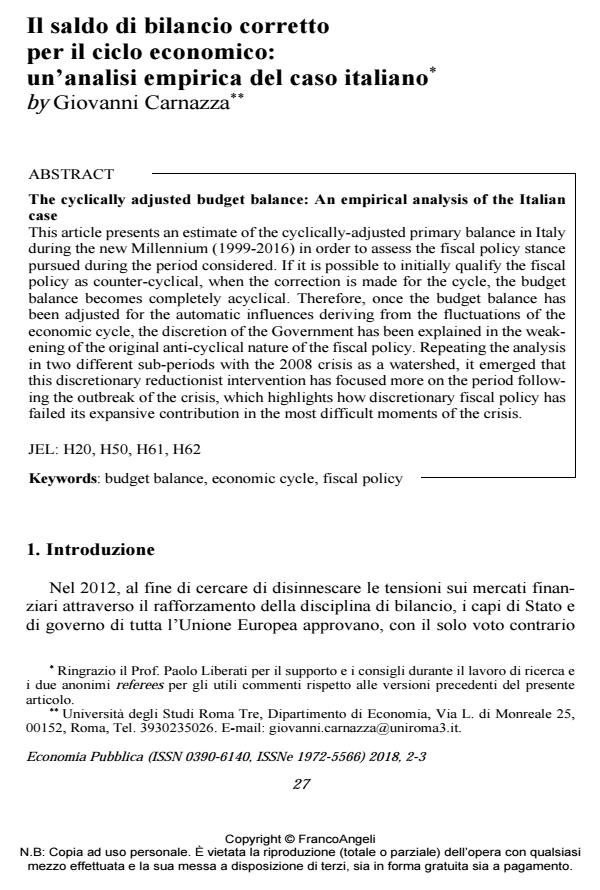Il saldo di bilancio corretto per il ciclo economico: un’analisi empirica del caso italiano
Journal title ECONOMIA PUBBLICA
Author/s Giovanni Carnazza
Publishing Year 2018 Issue 2018/2-3
Language Italian Pages 26 P. 27-52 File size 444 KB
DOI 10.3280/EP2018-002002
DOI is like a bar code for intellectual property: to have more infomation
click here
Below, you can see the article first page
If you want to buy this article in PDF format, you can do it, following the instructions to buy download credits

FrancoAngeli is member of Publishers International Linking Association, Inc (PILA), a not-for-profit association which run the CrossRef service enabling links to and from online scholarly content.
The cyclically adjusted budget balance: An empirical analysis of the Italian case This article presents an estimate of the cyclically-adjusted primary balance in Italy during the new Millennium (1999-2016) in order to assess the fiscal policy stance pursued during the period considered. If it is possible to initially qualify the fiscal policy as counter-cyclical, when the correction is made for the cycle, the budget balance becomes completely acyclical. Therefore, once the budget balance has been adjusted for the automatic influences deriving from the fluctuations of the economic cycle, the discretion of the Government has been explained in the weakening of the original anti-cyclical nature of the fiscal policy. Repeating the analysis in two different sub-periods with the 2008 crisis as a watershed, it emerged that this discretionary reductionist intervention has focused more on the period following the outbreak of the crisis, which highlights how discretionary fiscal policy has failed its expansive contribution in the most difficult moments of the crisis.
Keywords: Budget balance, economic cycle, fiscal policy
Jel codes: H20, H50, H61, H62
- Artoni R. e Biancini S. (2004). Il debito pubblico dall’Unità ad oggi. In: Ciocca P. e Toniolo G. (a cura di). Storia Economica d’Italia. Laterza.
- Blanchard O. J. (1990). Suggestions for a New Set of Fiscal Indicators. OECD Economics Department Working Papers, No. 79.
- Burnside C. e Meshcheryakova Y. (2005a). Cyclical Adjustment of the Budget Surplus: Concepts and Measurement Issues. In Burnside C. (a cura di). Fiscal Sustainability in Theory and Practice, a Handbook. The World Bank.
- Burnside C. e Meshcheryakova Y. (2005b). Mexico: A Case Study of Procyclical Fiscal Policy. In: Burnside C. (a cura di). Fiscal Sustainability in Theory and Practice, a Handbook. The World Bank.
- Chouraqui J., Hagemann R., P. e Sartor N. (1990). Indicators of Fiscal Policy: a Re-Examination. OECD Economic Department Working Papers, n. 78.
- D’Auria F., Denis C., Havik K., MC Morrow K., Planas C., Raciborski C., Roeger W. e Rossi A., (2010). The Production Function Methodology for Calculating Potential Growth Rates and Output Gaps. European Commission Economic Papers, n. 420.
- De Novellis F. e Signorini S. (2014). Tensioni finanziarie, austerità e recessione: un’incerta inversione di tendenza. La finanza pubblica italiana, rapporto 2014. il Mulino.
- De Novellis F. e Signorini S. (2016). Cenni di ripresa, tagli alle imposte e trattativa con l’Europa. La finanza pubblica italiana, rapporto 2016. il Mulino.
- Eser F. e Schwaab B. (2016). Evaluating the Impact of Unconventional Monetary Policy Measures: Empirical Evidence the ECB’s Securities Markets Programme. Journal of Financial Economics.
- Fantacone S., Garalova P. G. e Milani C. (2015). Deficit strutturali e politiche di bilancio: i limiti del modello europeo. Rivista di Politica Economica.
- Havik K., Mc Morrow K., Orlandi F., Planas C., Raciborski R., Roger W., Rossi A., Thum-Thysen A. e Vandermeulen V. (2014). The Production Function Methodology for Calculating Potential Growth Rates & Output Gap. European Commission Economic Papers, n. 535.
- Hodrick R. e Prescott E. C. (1997). Postwar U.S. Business Cycles: An Empirical Investigation. Journal of Money, Credit and Banking, 29. Mourre G., Isbasiou G. M., Paternoster D. e Salto M. (2013). The Cyclically-Adjusted Budget Balance Used in the EU Fiscal Framework: an Update. European Commission Economic Papers, n. 478.
- Mourre G., Astarita C. e Princen S. (2014). Adjusting the Budget Balance for the Business Cycle: the EU Methodology. European Commission Economic Papers, n. 536.
- Palumbo A. (2015). Studying Growth in the Modern Classical Approach: Theoretical and Empirical Implications for the Analysis of Potential Output. Review of political economy, 27: 3.
- Pisauro G. (2007). I conti pubblici nel 2006: il miglioramento inatteso. La finanza pubblica italiana, rapporto 2007. il Mulino.
- Pisauro G. (2009). I conti pubblici tra l’incudine e il martello. La finanza pubblica italiana, rapporto 2009. il Mulino.
- Pisauro G. (2010). I conti pubblici: quota 115 dopo il decennio perduto. La finanza pubblica italiana, rapporto 2010. il Mulino.
Giovanni Carnazza, Il saldo di bilancio corretto per il ciclo economico: un’analisi empirica del caso italiano in "ECONOMIA PUBBLICA " 2-3/2018, pp 27-52, DOI: 10.3280/EP2018-002002